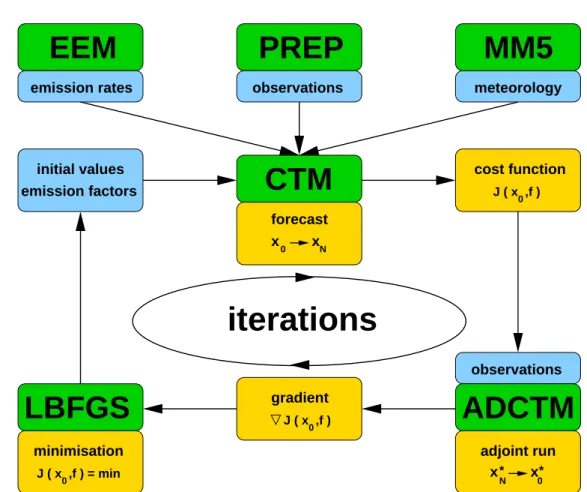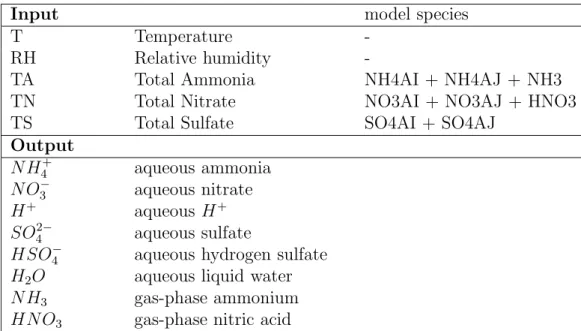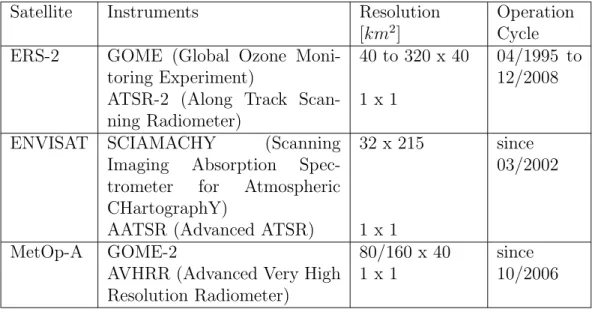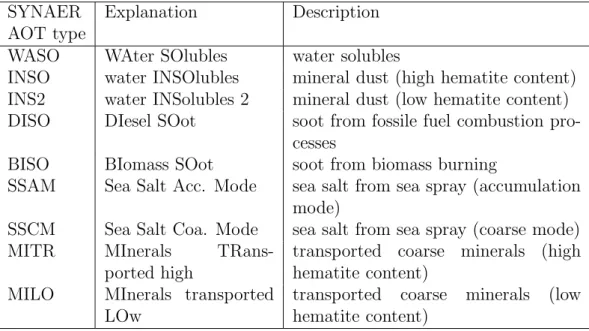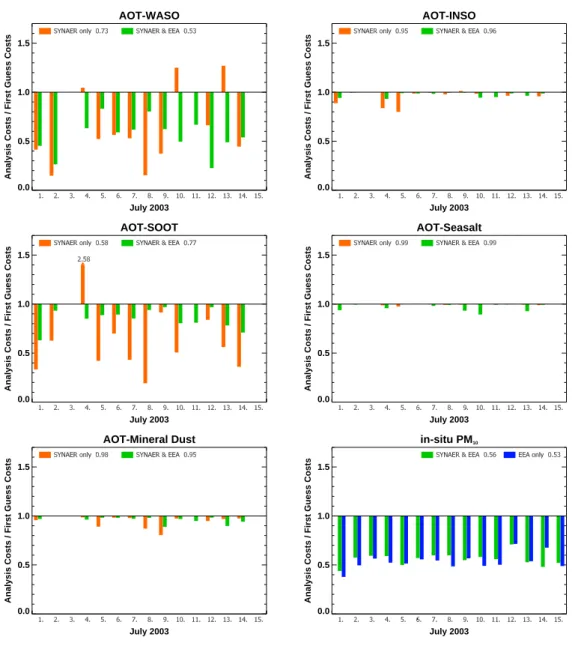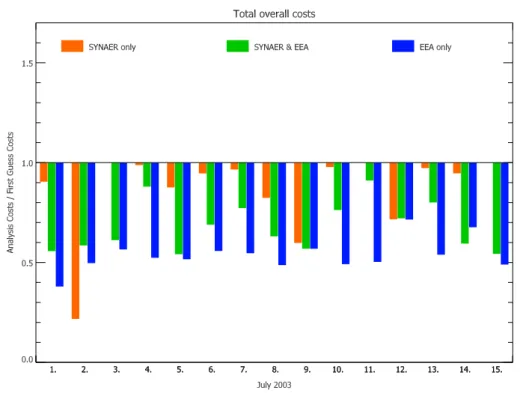Four-dimensional variational assimilation of aerosol data from in-situ and
remote sensing platforms
I n a u g u r a l – D i s s e r t a t i o n zur
Erlangung des Doktorgrades
der Mathematisch–Naturwissenschaftlichen Fakult¨at der Universit¨at zu K¨oln
vorgelegt von
Lars Peter Nieradzik
aus Siegen
K¨oln, 2011
Tag der letzten m¨ undlichen Pr¨ ufung: 18.10.2011
iii
Abstract
Aerosol data assimilation is mainly restricted to he ingestion of particulate
matter measurements up to 10
µmparticle size or aerosol optical depths. The
chemistry transport model EURAD-IM of the Rhenish Institute of Environ-
mental Research (RIU) containing a sophisticated 4D-var assimilation scheme
for gas-phase constituents has been expanded by a partial adjoint of the aerosol
module MADE to enable the assimilation of species resolved aerosols data in
space and time. To set the stage for four dimensional aerosol data assimilation,
the I/O-mapping technique HDMR (High Dimensional Model Representation)
had been applied to replace the computationally demanding chemistry mecha-
nism for secondary inorganic aerosols within MADE. An adjoint of the HDMR
was constructed and the inverse transport was ensured to allow the optimisa-
tion of aerosol initial values. Furthermore, several observation operators and
their respective adjoints were built to make the processing of various types
of measurements feasible. This set of operators includes integrators for in-
situ measured
P Mxas well as particle number densities. Within the scope
of the AERO-SAM project a radiative transfer model, part of a satellite re-
trieval system SYNAER, was implemented. Its prominent feature is to provide
type resolved aerosol optical thicknesses. With construction and implementa-
tion of the adjoint radiative transfer model, EURAD-IM is able to assimilate
species resolved aerosol information. The newly formed aerosol assimilation
scheme has been applied to two dedicated episodes. First, July of 2003 was
selected when an enduring high pressure area lasted over Europe. The very
dry period allowed excessive aerosol concentrations in the troposphere. This
particular timeframe was taken to evaluate the functionality of the aerosol
assimilation system and to validate the benefit of assimilating
P M10and espe-
cially species resolved satellite retrievals. Further, the airborne measurement
campaign ZEPTER-2 in autumn 2008 was chosen. A Zeppelin equipped with a
condensation particle counter (CPC) delivered particle number densities with
high spatial and temporal resolution. Here, the focus was set on the validation
of the assimilation system of particle number densities and its performance on
high resolved grids. In both cases initial value optimisation has been conducted
and performance of the assimilation system and its impact on the forecast have
been investigated. The studies demonstrate a considerable improvement of the
forecast quality regardless of grid resolution. Moreover, making use of aerosol
type resolved retrievals and particle number densities adds valuable informa-
tion on the aerosol properties to the model.
Kurzzusammenfassung
Die Assimilation von Aerosoldaten war bisher im Wesentlichen auf die Verwen-
dung von Messungen der Gesamtmassenkonzentrationen von Partikeln bis zu
einer bestimmten Gr¨oße und Messungen von optischer Tiefe beschr¨ankt. Das
Chemie-Transport-Modell EURAD-IM des Rheinischen Instituts f¨ur Umwelt-
forschung (RIU) enh¨alt ein hochentwickeltes vierdimensionales variationales
(4D-var) Assimilationssystem f¨ur Gasphasenspezies, das nun um eine teilwei-
se adjungierte Version des Aerosol-modells MADE erweitert wurde, um spe-
ziesaufgel¨oste Aerosolmessungen assimilieren zu k¨onnen. Vorbereitend wurde
bereits der ¨ausserst rechenzeitaufwendige Mechanismus zur L¨osung der Che-
mie der sekund¨aren anorganischen Aerosole innerhalb des MADE mithilfe ei-
nes I/O-mapping-Verfahrens ersetzt. Der resultierende Algorithmus wurde nun
adjungiert und die Funktionalit¨at des adjungierten Aerosoltransportes sicher-
gestellt. Desweiteren wurden verschiedene Beobachtungsoperatoren entwickelt
und gleichzeitig adjungiert. Dazu geh¨oren Integrationsroutinen f¨ur Massen-
konzentrationen und Anzahldichten. Im Rahmen des AERO-SAM Projektes
wurde ein Strahlungstransportmodell, Teil eines Satelliten-Retrieval-Systems,
in das Modell eingebaut. Die Besonderheit liegt darin, dass das Modell spe-
ziesaufgel¨oste aerosoloptische Tiefen liefert. Das so konstruierte Aerosolassi-
milationssystem ist auf zwei Episoden angewandt worden. Als erstes auf den
Sommer 2003, als ein langanhaltendes Hochdruckgebiet ¨uber Europa lag. Die-
se Wetterlage beg¨unstigte Waldbr¨ande und brachte stark erh¨ohte Feinstaub-
belastung mit sich. In diesem Zeitraum wurde das neue Assimilationssystem
getestet und der Nutzen der Assimilation von
P M10insbesondere von spe-
ziesaufgel¨osten Satellitendaten untersucht. Außerdem wurde die ZEPTER-2
Messkampagne aus dem Herbst 2008 ausgew¨ahlt. Ein zur Messplatform um-
gebauter Zeppelin, der mit einem CPC (Condensation Particle Counter) aus-
gestattet war, hat r¨aumlich und zeitlich hochaufgel¨oste Partikelanzahldichten
gemessen. In dieser Episode wurde der Fokus auf die Assimilation der Anzahl-
dichten sowie der Leistung des Systems auf Modellgittern mit hoher Aufl¨osung
gerichtet. In beiden F¨allen wurde Anfangswertoptimierung durchgef¨uhrt und
das System selbst, sowie das Verm¨ogen, die Vorhersage von Aerosolen zu ver-
bessern, untersucht. Es hat sich herausgstellt, dass sich durch Assimilation von
Aerosolen eine deutliche Verbesserung der Vorhersage insgesamt erzielen l¨asst,
w¨ahrend durch die Assimilation spezies-aufgel¨oster Retrievals zus¨atzlich die
Zusammensetzung der Aerosole angepasst werden kann.
Contents
1 Introduction 1
2 Data Assimilation 5
2.1 Bayes’ Probability . . . . 6
2.2 Maximum Likelihood and Minimum Variance . . . . 6
2.3 Variational data assimilation . . . . 8
2.4 4-dimensional variational data assimilation . . . . 8
2.5 Kalman Filtering . . . 10
2.6 Summary . . . 11
3 The model system EURAD-IM 13 3.1 The EURAD-CTM . . . 15
3.1.1 Functional principle . . . 15
3.1.2 Grid specifications . . . 17
3.1.3 Initialisation . . . 18
3.2 The aerosol model MADE . . . 18
3.2.1 Size distribution . . . 20
3.2.2 Aerosol dynamics . . . 21
3.2.3 Aerosol chemistry . . . 23
3.2.4 Emissions . . . 24
3.2.5 Adjoint chemistry for secondary inorganic aerosols . . . . 24
3.3 Nesting . . . 27
3.4 Observation operators . . . 28
3.4.1 Size integrated observations . . . 29
3.4.2 SYNAER - SYNergetic AErosol Retrieval . . . 31
4 Background Error Covariance Modeling 39 4.1 Processing of Background Error Covariances . . . 40
4.1.1 The incremental formulation of the costfunction . . . 40
4.1.2 The diffusion approach . . . 41
4.2 Obtaining B . . . 42
4.2.1 Isotropic and homogeneous . . . 42
4.2.2 Ensemble calculations . . . 43
4.2.3 The NMC - method . . . 43
4.3 Current setup . . . 45
5 Episode and Campaign Simulations 47 5.1 July 2003 . . . 48
5.1.1 Episode configuration . . . 49
5.1.2 Assimilation performance . . . 51
5.1.3 Forecast performance . . . 54
5.1.4 Optimised Initial Values . . . 61
5.1.5 Summary . . . 66
5.2 ZEPTER-2 Campaign 2008 . . . 68
5.2.1 Model configuration . . . 70
5.2.2 Assimilation configuration . . . 70
5.2.3 Available observations . . . 72
5.2.4 Assimilation performance . . . 74
5.2.5 Forecast performance . . . 78
5.2.6 Optimised Particle Number Densities . . . 82
5.2.7 Summary . . . 86
6 Conclusions and Outlook 87
A Vertical Grid Structure 91
B Available ZEPTER-2 Measurements 93
CONTENTS vii
C ZEPTER-2 Flights 97
Bibliography 109
Acknowledgements 117
List of Figures
3.1 Schematic survey of the EURAD-IM model mystem . . . 14
3.2 Schematic survey of the MADE . . . 19
3.3 Log-normal distribution of number and volume density . . . 30
3.4 Footprint-H-Operator . . . 37
4.1 Schematic overview of the NMC method . . . 44
4.2 Horizontal diffusion coefficients for
P M10. . . 45
5.1 MODIS thermal anomalies July 2003 . . . 48
5.2 Schematic overview of model runs . . . 50
5.3 Available Measurements July 2003 . . . 53
5.4 Specieswise minimisation performance July 2003 . . . 55
5.5 Relative reduction of total costs 2003 . . . 56
5.6 Overall relative cost reduction 2003 . . . 57
5.7 Specieswise daily forecas performance July 2003 . . . 58
5.8 In-situ
P M10Bias and RMSE 2003 . . . 59
5.9 Error statistics for in-situ
P M10. . . 60
5.10 Analysis and increments of accumulation mode
SO42−(WASO) . 62 5.11 Analysis field and increments of coarse mode anthropopgenic aerosols (INSO ) . . . 63
5.12 Analysis field and increments of accumulation mode elemental
carbon (SOOT ) . . . 64
5.13 Analysis field and increments of coarse mode sea salt (SEAS ) . 65
5.14 Analysis field and increments of mineral dust VSOILA . . . 66
5.15 Analysis field and increments of
P M10. . . 67
5.16 Assimilation schedule . . . 72
5.17 Domains and in-situ measurements ZEPTER-2 . . . 73
5.18 Assimilation performance, ground and satellite observations . . 75
5.19 Assimilation performance, airborne and total . . . 76
5.20 Comparison of
P M2.5and
P M10. . . 77
5.21 Time series of
P M2.5and
P M10. . . 78
5.22 Forecast performance of
P M10on nested grids . . . 79
5.23 Bias reduction on nested grids . . . 80
5.24 Munich-Stachus vs. Istanbul-Aksaray . . . 81
5.25 Measured
P ND3along track of flight 14 . . . 82
5.26
P ND3assimilation of Flight F14 . . . 83
5.27
P ND3analysis increments for flight F14 . . . 84
5.28
P ND3analysis increments for flight F14 (vertical cross section) 85 C.1 PND assimilation of Flight F13 . . . 98
C.2 PND assimilation of Flight F15 . . . 99
C.3 PND assimilation of Flight F16 . . . 100
C.4 PND assimilation of Flight F17 . . . 101
C.5 PND assimilation of Flight F18 . . . 102
C.6 PND assimilation of Flight F19 . . . 103
C.7 PND assimilation of Flight F20 . . . 104
C.8 PND assimilation of Flight F21 . . . 105
C.9 PND assimilation of Flight F22 . . . 106
C.10 PND assimilation of Flight F23 . . . 107
List of Tables
3.1 Standard deviations and initial diameters of the modes in MADE. 21 3.2 Aerosol species and number concentration processed in MADE
and their modal assignment. Species denominations are taken from MADE source code. . . 22 3.3 Input and output parameter and their relation to the model
species . . . 26 3.4 List of satellite instruments the SYNAER retrieval has been
adapted to. Operational cycles taken from http://earth.esa.int . 32 3.5 SYNAER AOT types as used within retrieval and as delivered
in data product according to Holzer-Popp et al. [2008] . . . 33 3.6 Predefined mixtures within the SYNAER retrieval. . . 34 3.7 Mapping of the SYNAER AOT types onto a reduced set of
EURAD-IM SYNAER-H-Operator AOT types for the use in data assimilation. Tolerances are maximum values for which the H-Operator is valid . . . 35 3.8 List of types of SYNAER aerosol optical thicknesses and the
EURAD-IM contributing species separated by mode. See Table 3.2 for a detailed description of EURAD-IM Species . . . 36 5.1 Assimilation schedule for the episode of July 2003. Assimilation
specifications and the number of available observations for each
day of the episode. While EEA stations deliver hourly values,
each single SYNAER pixel is counted. . . . 52
5.2 List of ZEPTER-2-flights . . . 69 5.3 Configuration of the Zepter-2 nested grids. Computing time
refers to a 72-hour forecast. . . 70 5.4 Data assimilation configuration used on the nested grids during
the ZEPTER-2 campaign . . . 71 A.1 Vertical structure of the model grid . . . 91 B.1 Number of available EEA in-situ stations and total number of
P ND3
and SYNAER AOT observations for the 45 km EUR grid. 94 B.2 Number of available EEA in-situ stations and total number of
P ND3
and SYNAER AOT observations for the 15 km CEN grid. 95 B.3 Number of available EEA in-situ stations and total number of
P ND3
and SYNAER AOT observations for the 5 km ZP2 grid. 96
List of Acronyms
AATSR
Advanced ATSR
3D-var
Three-Dimensional Variational
4D-varFour-Dimensional Variational
AERONETAErosol RObotic NETwork
AERO-SAM
AEROsol characterization from Space by advanced data Assimilation into a tropospheric chemistry Model
AOD
Aerosol Optical Depth
AOT
Aerosol Optical Thickness
AVHRR
Advanced Very High Resolution Radiometer
BECMBackground Error Covariance Matrix
BLAOT
Boundary Layer Aerosol Optical Thickness
BLUEBest Linear Unbiased Estimate
CPC
Condensation Particle Counter
CTM
Chemistry Transport Model
DFD
Deutsches Fernerkundungsdatenzentrum
DFG
Deutsche Forschungsgemeinschaft German Science Foun- dation
DLR
Deutsches Zentrum f¨ ur Luft- und Raumfahrt
ECMWF
European Centre for Medium-Range Weather Forecast
EEA
European Environment Agency
EEM
EURAD Emission Model
EnKF
Ensemble Kalman Filter
ENVISAT
ENVIronmental SATellite
ERS-1/2
European Remote sensing Satellite 1 and 2
EURAD-IM
European Air Pollution Dispersion - Inverse Model
FEOMFully Equivalent Operational Model
GOME
Global Ozone Mapping Experiment
GOME-2
second Global Ozone Monitoring Experiment
GPSGlobal Positioning System
HDMR
High Dimensional Model Representation
KF
Kalman Filter
L-BFGS
Limited-Memory Broyden Fletcher Goldfarb Shanno
MADEModal Aerodol Dynamics model for Europe
MetOp-A
METeorological OPerational satellite-A
MIM
Mainz Isoprene Mechanism
MM5
Fifth-Generation NCAR / Penn State Mesoscale Model
MODISMODerate-resolution Imaging Spectroradiometer
NASANational Aeronautics and Space Administration
NCARNational Center for Atmospheric Research
NCEPNational Center for Environmental Prediction
NMCNational Meteorological Center
RACM
Regional Atmospheric Chemistry Mechanism
RADMRegional Acid Deposition Model
RIU
Rheinisches Institut f¨ ur Umweltforschung
RPMRegional Particulate Model
RPMARES
Regional Particulate Model Aerosol REacting System
SCIAMACHYScanning Imaging Absorption Spectrometer for Atmo-
spheric Chartography
SORGAM
Secondary ORGanic Aerosol Model
SPRINTARS
Spectral Radiation-Transport Model for Aerosol Species
SYNAERSYNergistic AErosol Retrieval
UTC
Coordinated Universal Time
VOCVolatile Organic Compounds
WRF-chem
Weather Research and Forecast (WRF) model coupled with CHEMistry (WRF-Chem)
ZEPTER-2
second ZEPpelin based Tropospheric photochemical
chemistry expERiment
CHAPTER 1
Introduction
Since the advent of numerical atmospheric modeling in the 1950ies there has been an endeavor to enhance the models’ prediction skills and to process a maximum of available information to achieve a representation of the state of the atmosphere that is as accurate as possible. The complexity of models has been rising with the increase of computational power. The spatial and tempo- ral resolution of model grids has become increasingly finer, the representation of physical processes has become more elaborate, and, in terms of chemistry transport modeling, the number of chemical compounds and, hence, reactions has become larger. But still, it is apparent that a good prediction does need a reasonable estimate to start from, a set of optimum initial values. The pro- vision of initial values by employing as much available information as possible is the traditional goal of data assimilation. It combines the new, yet mostly sparse information from observations with the physical and chemical knowl- edge of atmospheric processes encoded in the numerical models.
From numerical weather simulations (see for example Lorenc [1986]) the vari- ous techniques consequently found their way to chemistry transport modeling.
Here, the works of Elbern et al. [1997] and Elbern and Schmidt [2001] showed
the usefulness of a four dimensional variational data assimilation (4D-var) sys-
tem applied to provide both, optimised initial values as well as optimised emis-
sion factors, with EURAD-IM (EURopean Air pollution Dispersion - Inverse
Model, Ebel et al. [1993], Ebel et al. [1997]). In 1997 the ECMWF (European
Centre for Medium-Range Weather Forecast) developed the first meteorologi-
cal 4D-var system for operational use (Rabier et al. [2000]).
In the recent decade aerosols more and more came into the view of science and politics. Their impact on human health has been investigated largely, as shown by Brimblecombe and Maynard [2001] or the CAFE report by European Commission [2005]. Furthermore, the significance of aerosols concerning the earth’s radiative budget and, hence, influencing the global climate (Intergov- ernmental Panel on Climate Change [2001]) motivates efforts to get a best possible estimate of the atmospheric aerosol burden. Their impact can be di- rect, in terms of scattering, reflection, and absorption of solar light as well as the earth’s long wave radiation, the so called “direct forcing”. On the other side, aerosols act as cloud condensation nuclei (CCN) with the effect of an increased rate of cloud formation leading to an enhanced albedo. This effect is called “indirect forcing”.
Various effects of aerosols do not only depend on their physical properties but
also on their composition. Salt aerosol mainly found in coastal areas but also
induced deliberately in health resorts is said to have a positive effect on the res-
piratory system. On the other side mineral dust from volcanic eruptions may
cause serious damage to aircrafts. These very distinct effects of the different
substances an aerosol can be composed of brings up the necessity for differ-
entiated aerosol simulations. While this is already standard in many aerosol
models, there still is a lack of type resolved aerosol measurements to either
evaluate the models or to assimilate them. The first steps in 3D-var assimila-
tion of AOT into a model with evolving aerosols were accomplished by Collins
et al. [2001] using four species, sulfate, carbonaceous, mineral dust, and sea
salt. More recently, Kahnert [2009] showed the beneficial impact on aerosol
forecast by applying 3D-var on AOT in a model using seven species in four size
bins. Also, Pagowski et al. [2010] showed the valuable impact of optimised ini-
tial values by 3D-var of ground based
P M2.5. This study was conducted with
MADE. Another approach with Ensemble Kalman Filtering (EnKF) was made
by Schutgens et al. [2010] using a two species parameterisation (fine and coarse
mode particles) for the assimilation of AERONET AOD (AErosol RObotic
NETwork) in the SPRINTARS model (Spectral Radiation-Transport Model
for Aerosol Species). The ECMWF is currently operating a 4D-var-scheme
with three size bins each for dust and sea salt and one size bin each for or-
ganics, black carbon, and sulfate assimilating unspecified MODIS (MODerate-
resolution Imaging Spectroradiometer) AOD (Benedetti et al. [2009]). All of
the studies mentioned above use bulk measurements for assimilation, i.e. inte-
grated values like
P Mxor AOT that give no information on the aerosol com-
position. Even more, these model setups are bound to their modeled aerosol
3
compositions, since all of them use the technique of repartitioning (reassigning the analysis to the a priori composition of aerosols). While 4D-var is able to assimilate measurements “where and when they are”, the EnKF needs to accumulate the measurement into several assimilation windows. The 3D-var approach generates new model states at one point in time. Except for the study presented by Pagowski et al. [2010] whose model has a resolution of 12 km, all simulations have been accomplished on rather coarse grids with spac- ings of 25 km and more.
So far, the inverse modeling of the physical properties of aerosols in a box model was given by Sandu et al. [2005], who presented an adjoint of the coagulation scheme, and Henze et al. [2004] who introduced an inverse mechanism for con- densational growth.
Addressing the above characteristics this study presents an assimilation sys- tem, that
•
is capable of ingesting type resolved observations,
•
can process particle properties, namely particle number densities,
•
is applicable on highly resolved grids,
•
and delivers smooth and timely coherent analysis fields as an intrinsic property of the 4D-var approach..
First of all, the proper observations need to be at hand. Besides the few so
called super sites which measure separate aerosol components like sulphate, ni-
trate, or chloride most of the available aerosol in-situ observations deliver lump
measurements that contain only the overall mass concentration of particles up
to a certain diameter, like
P M10. Another important source of information
on atmospheric aerosols are remote sensing instruments aboard several satel-
lites which in general deliver overall aerosol optical thicknesses. Here, again,
no information on the composition of the aerosol is contained. However, the
SYNAER retrieval system (Holzer-Popp et al. [2002b]) developed at DLR-DFD
offers type resolved aerosol optical thicknesses and, thus, the opportunity to
assimilate not only AOT, but also assign it to certain species contained in
the model. Finally, this leads to a more comprehensive representation of the
atmosphere’s aerosols. As another novelty, particle number densities with a
high temporal resolution gathered during an airborne measurement campaign
were at hand.
The four dimensional variational data assimilation system for aerosols was added to the already existing foundation of a sophisticated gas-phase 4D-var system. The aerosol model MADE (Modal Aerodol Dynamics model for Eu- rope, Ackermann [1997], Ackermann et al. [1998]) was expanded by an adjoint condensation scheme. Therefore, the original condensation scheme (Friese and Ebel [2010]) was replaced by a FEOM (Fully Equivalent Operational Model, Nieradzik [2005]) based on the principle of HDMR (High Dimensional Model Representation, see Rabitz and Alis [1999]). This FEOM consists of a set of multidimensional multivariate functions which, besides being much faster in computation than its predecessor, facilitates the building of an adjoint.
Furthermore, the respective observation operators for the various observations have been built. Altogether, it proves to be a skillful tool to improve mesoscale simulation of tropospheric aerosols.
This study is organised as follows: In chapter 2 an overview is given on four dimensional variational data assimilation including a comparison with the most common data assimilation techniques. Subsequently the EURAD-IM model system and its aerosol model MADE are introduced in chapter 3 along with the newly implemented algorithms. Chapter 4 addresses the various types of aerosol related measurements which the EURAD-IM is now able to assimilate.
Furthermore, the observation-operators necessary to map from model space to
observation space and their adjoints are presented here. The application of the
aerosol assimilation system on two selected episodes is illustrated in chapter
5, along with validation results of the system and an evaluation of the impact
of optimised aerosol initial values on the forecast quality. This thesis finally
concludes in chapter 6 where a summary and an outlook on future research
options is given.
CHAPTER 2
Data Assimilation
Numerical models used in atmospheric sciences are always a simplified repro- duction of the real atmosphere. They are limited in terms of their spatial and temporal resolution and to a restrictive selection of physical and chemical pro- cesses. This is a necessary trade off between accuracy and diversity (e.g. the number of species treated) on one side and computational power limitations on the other. Numerical modeling is an initial value/boundary conditions prob- lem. Hence, the model performance will be aligned to the grade of knowledge of these. Since these conditions themselves are only modeled, i.e. the out- come of a preceeding simulation, or a fixed set of climatological average values based on long term observations or investigation of relevant data sets, they are generally far from ideal. Altogether, numerical models are limited to the knowledge encoded by their programmers in form of physical laws, chemical reactions, orographic information, and the like.
Another source of information on the state of the atmosphere are measure- ments. They can provide a detailed insight into the atmosphere’s current condition, be it on a large scale in form of satellite retrievals or be it in-situ measurements from ground based or airborne instruments. Unfortunately, this multitude of information does not directly provide the necessary initial con- ditions to the model, since they themselves underlay a variety of limitations.
First of all, their spatial distribution tends to be rather inhomogeneous and
many measurement sites are not representative for an area of the size of a
model grid cell. Often the desired species are not measured directly, e.g. satel-
lite retrievals of aerosol optical thicknesses instead of aerosol concentrations,
and, finally, they are afflicted with errors.
The techniques summarised under the concept of Data Assimilation have evolved from the desire of ”using all available information, to determine as accurately as possible the atmospheric (or oceanic) flow” as defined by Tala- grand [1997]. Data assimilation acts as an interface between the various types of information on the state of the atmosphere on one side and the knowledge of the physical and chemical processes in the atmosphere on the other. While observations of the atmosphere’s state and composition can be very exact they are limited in time and space. Models, on the other hand, deliver a continuous and smooth image of the atmosphere but are restricted to discretisation and a limited set of equations describing the major processes. To retrieve a max- imum gain of information from both these scientific tools is the goal of data assimilation.
This chapter outlines the theory of data assimilation. Furthermore, a rough survey of the various methods will be given before the variational approach, which has been applied in this work, will be described in detail. For a more comprehensive comparison of these methods see e.g. Kalnay [2003], Lahoz et al. [2010].
2.1 Bayes’ Probability
Assume, that there is a probability density function (PDF)
p(x) for the stateof the atmosphere
xwhich can be derived, e.g. from an ensemble simulation or climatology. This is the a priori probability to simulate
x. Furthermore,if an information
yon the condition is known - a measurement - and its error characteristics are available, a PDF
p(y|x) can be formulated. It describes theprobability of taking a measurement
ywhen condition
xholds.
Following Bayes’ theorem, the a posteriori probability
p(x|y) can be derivedby
p
(x
|y) = p(y
|x)p(x)
p
(y) =
p(y
|x)p(x)
R p
(y
|x′)
p(x
′)
dx′(2.1)
2.2 Maximum Likelihood and Minimum Vari- ance
With the further assumption that these PDFs are of Gaussian character and
σybeing the standard deviation of
y, the probability of measuring ywhen the
2.2 Maximum Likelihood and Minimum Variance 7
true state
xis given can be expressed as
pσy(y
|x) =1
√
2πσ
y ·e−(y−x)2 2σ2
y .
(2.2)
On the other side, the likelihood of
xas the true state given
yis simply
Lσy
(x
|y) =pσy(y
|x)(2.3)
In the presence of a multitude of
Nmeasurements the overall likelihood be- comes
Lσy1,...,σyN
(x
|y1,...,N) =
N
Y
i=1
√
1
2πσ
y2i ·e−(yi−x)2
2σ2 yi
!
= 1
√
2π
Nσy21· · ·σy2N ·e−(y1−x)2 2σ2
1
···−(yN−x)2
2σ2
N ,
(2.4)
the joint probability. Consequently, the maximum of 2.4 is most likely to be true value of
x. Neglecting the constant factor and taking into account thatthe logarithm is a monotonous function yields
max Lσy1,...,σyN
(x
|y1,...,N)
=
maxconst
.−(y
1−x)22σ
y21 −. . .−(y
N −x)22σ
y2N!
.
(2.5)
Taking another look at Bayes’ Theorem and assuming that
p(x) can be con- sidered a prior PDF of the true state in the presence of an information
x0(the background information, also referred to as the first guess) that also yields a Gaussian probability in the form of
px0,σ0(x) = 1/
√2πσ
0·e−(x0−x)2/2σ20
one can write the a posteriori probability of 2.2 as
p
(x
|y) = pσy(y
|x)px0,σ0(x)
pσy(y) =
N
Y
i=1
√
1 2πσ
yi·e−
(yi−x)2
2σ2 yi
!
·
1
√
2πσ
x0·e−
(x0−x)2 2σ2
x0
(2.6)
The right term in 2.2 shows that the denominator is independent of
x, and thus,its maximum can be obtained by maximising the numerator in an analogous
manner as in 2.5.
2.3 Variational data assimilation
Maximising 2.5 delivers the most likely state of the atmosphere
xa, the so called Analysis. In data assimilation this is technically done by minimising a Cost Function
J(x). It is gained by multiplying 2.5 by−1 and it contains the sum of the squares of the misfit of each of the observations and the background field to the state vector
xweighted by their individual variance:
J(x) =
1 2
"
(y
−x)22σ
y2+ (x
−xb)
22σ
x2b#
(2.7) or, as it is generally written in data assimilation:
J(x) =
1 2
h
(H(x)
−y)TR
−1(H(x)
−y) + x−xbTB
−1 x−xbi(2.8) with the superscript
Tindicating the transposed of a vector, R the obser- vation or measurement error covariance matrix, and B the background error covariance matrix.
H(x) is called theobservation or forward operator. It is a mapping from the model space into the space of the observation. This can be a simple multilinear interpolation from the model grid to the location of the measurement, but might as well be as complex as a full radiative transfer model. Different types of H-operators and their properties will be discussed in section 3.4. An important property of this formulation of the cost function is, that it is minimised with respect to
x. The calculus described above isstationary in time, i.e. it delivers a BLUE (Best Linear Unbiased Estimate) of the model state for one point in time. It is therefore referred to as Three Dimensional variational data assimilation (3D-var).
2.4 4-dimensional variational data assimilation
It is desirable to make use of as many measurements as possible. But these are generally distributed not only in space but also in time. To find an optimum for the state of the atmosphere at a time
t0(henceforth reffered to as initial time) taking into account all measurements within a certain temporal interval the costfunction 2.8 has to be modified to
J(x0
) =
Jb+
JO= 1
2
x0 −xbTB
−1 x0−xb+ 1
2
N
X
i=1
[H (M
i(x
0)
−yi)]
TR
−1[H (M
i(x
0)
−yi)]
(2.9)
2.4 4-dimensional variational data assimilation 9
where
Mis the model operator generating the state
xiat timestep
ifrom the initial conditions
x0, y
iis a vector containing all observations at timestep
i. The costfunction J(x0) is now minimised to gain an optimum state
xa0, the analysis, i.e. a BLUE of the initial conditions of the assimilation interval with respect to all observations within this interval. Minimisation is done by numerical methods, like a Conjugate Gradient or a quasi-Newton algorithm.
It is accomplished by building the gradient of
J(x
0) and approaching its zero.
One constraint that is made in 4D-var is that the model is assumed to be errorless over the whole interval. Only the initial values are afflicted with errors. The gradient of
J(x0) with respect to
xbcan easily be derived from Equation 2.9 resulting in
∇x0Jb
= B
−1 x0−xb(2.10) Quite similarly, the gradient of the observational part of the costfunction can be calculated
∇xiJo
= H
TR
−1(H(x
i)
−yi) (2.11)
here, the gradient is valid at time
tibut the gradient is needed for
t0. Now, let
δx0be a perturbation at
t= 0, then, using the model operator
Mfrom Equation 2.9 the perturbation at
t=
ican be defined as
δxi
:= M
i(x
0+
δx0)
−M
i(x
0) (2.12)
The tangent linear model M
′is a linear approximation of the model operator
M, its Jacobian. It can thus be stated that
δxi ≈
M
′i(δx
0) (2.13)
Making use of the canonical scalar product
< u, v >=Piui·vi
one can write a variation of
J(x) as a result of
δxias
δJ ≈<∇xiJ, δxi >
This way, the term of observation costs in 2.9 can be written as
δJo=
N
X
i=0
<∇xiJo, δxi >
and with the assumption that 2.13 holds this transforms to
δJo=
N
X
i=0
<∇xiJo,
M
′i(δx
0)
>(2.14)
Now, using the property
< u, Cv >=< CTu, v >the variation of
Joturns to
δJo=
N
X
i=0
<
M
∗i∇xiJo, δx0 >(2.15) where, M
∗:= M
′Tis the transpose of the tangent linear, the adjoint model.
The gradient of the observation costfunction can now be derived for
t= 0 recalling 2.11
∇x0Jo
=
N
X
i=0
M
∗i∇xiJo=
N
X
i=0
M
∗iH
TR
−1(H(x
i)
−yi) (2.16) Now, the whole costfunction with respect to the gradients at
t= 0 can be summed up to
∇x0J
=
∇x0Jb+
∇x0Jo= B
−1 x0 −xb+
N
X
i=0
M
∗iH
TR
−1(H(x
i)
−yi) (2.17)
2.5 Kalman Filtering
The most sophisticated yet complex method is the Extended Kalman Filter, often referred to as the ”Gold Standard of data assimilation” (Kalnay [2003]) in contrast to the 4D-var method it delivers the analysis error covariance matrix
Piaat every timestep
iand does take into account the error produced by the model while propagating in time. According to Kalnay [2003] this can be summarised as follows: Let
xfibe the forecasted model state at
t=
ipropagated by the Model
Mfrom the analysis
xai−1at the preceding time-step
t=
i−1 then the forecast can be described as
xfi
=
Mi−1 xai−1(2.18) and a forecast error covariance matrix P
figained by propagation of P
ai−1via
P
fi= L
i−1P
ai−1L
Ti−1+ Q
i−1(2.19)
where L
iis the Tangent Linear Model, a linear approximation of the model
Mat timestep
iunder the condition of
xai, and L
Tiits transposed or so called
adjoint. Q
iis a matrix representing the noise of the model, i.e. the error
inflicted by the model itself. Furthermore, H
iis used in the following being
2.6 Summary 11
the linearisation of the forward operator
Hat the state
xfi. Now, the analysis for timestep
ican be computed by first minimising P
a(t
i) in
P
ai= (I
−K
iH
i) P
fi(2.20)
and finally updating
xai xai=
xfi+ K
iy
i−H(xfi)
(2.21) with K being the so called Kalman gain matrix that is set up after the forecast steps as
K
i= P
fiH
Ti hR
i+ H
iP
fiH
Ti−1(2.22) Equation 2.19 describes the crucial step in extended Kalman Filtering. With L being of the size of the degrees of freedom of the model (which can easily be of the order of 10
7or more), the step of propagating P
ain time is as costly as the same number of model forward integrations. This prohibits the use of extended Kalman Filters for common problems. Several techniques have been developed, to enhance performance by reducing model size or making reason- able assumptions, like e.g. the ensemble Kalman filter, which are described in detail in Kalnay [2003], Lahoz et al. [2010] or Daley [1991].
2.6 Summary
In operational model set-ups it is common to apply pseudo-4D data assimila- tion. That is, applying a 3D-var scheme at, for example, every full hour. This is due to computational demands of a full 4D-var system on one hand but, above all, because no adjoint model needs to be constructed or maintained.
In 4D-var assumptions have to be made about the background error covari-
ance matrix B while the extended Kalman Filter propagates the model error
in time and, thus, delivers the more complete description of the state of the
atmosphere. This is, on the other hand, not feasible for standard models due
to the immense computational effort. Also, does the 4D-var analysis deliver
a smooth and physically and chemically consistent state within the assimila-
tion window, while Kalman filtering produces perturbations through jumps
whenever an analysis step is performed.
CHAPTER 3
The model system EURAD-IM
The EURAD-IM model system has been developed on the base of the EURAD- CTM (EURopean Air pollution Dispersion - Chemistry Transport Model).
The suffix IM (Inverse Model) indicates that EURAD-CTM has been expanded by an inverse part for data assimilation purposes. The forward part of the model system - the standard forecast system - consists of three major models:
•
MM5
The Mesoscale Meteorological model 5 (Grell et al. [1994]) acts as me- teorological driver for the CTM, i.e. it delivers the meteorological fields needed like, for example, wind, relative humidity, and temperature.
•
EEM
The EURAD-Emission-Model (Memmesheimer et al. [1991]) delivers emis- sion fields taylored for the specific grid used considering diurnal cycle, day of the week, international holidays, and season.
•
CTM
The chemistry transport model (Hass [1991]; Hass et al. [1995]; Ebel et al.
[1997]) computes transport, chemical transformation, and deposition of
gas-phase and aerosol-phase species.
iterations EEM
emission rates
PREP
observations
MM5
meteorology
x x0 N
CTM
forecast initial values
emission factors
J ( x ,f )0
x x
N 0
* * J ( x ,f )0
J ( x ,f ) = min0
observations gradient
ADCTM
adjoint run cost function
minimisation
LBFGS
Figure 3.1: Schematic survey of the EURAD-IM model system. Explanation in the text.
The inverse model system contains three additional parts.
•
PREP
The data PREProcessor provides desired measurement data from any kind of available measurement.
•
ADCTM
Adjoints of many of the forward routines (in 4Dvar only), H-operators for the mapping between model and observation space.
•
LBFGS
The implemented minimisation algorithm that evaluates gradient and
costfunction is the Limited-memory Broyden-Fletcher-Goldfarb-Shanno
algorithm (Liu and Nocedal [1989]).
3.1 The EURAD-CTM 15
The EURAD-IM is a Eulerian model system. The chemistry is calculated on a fixed three dimensional grid and transport is simulated as fluxes through the boundaries of each grid cell. The meteorological driver MM5 and the EEM are run offline, thus, there is no feedback from the CTM. Figure 3.1 displays the calling sequence of the particluar model components and the data flow within a model simulation. A standard forecast simulation is composed of the sequential call of MM5, EEM, and CTM, though in a newer version, an online-version of the EEM is available, where emissions are calculated within the CTM. Four dimensional fields of concentrations of gas-phase and aerosol phase species are delivered as output.
An assimilation run is setup with additional featuers. First, another offline process, the PREP is run offline to provide desired observations in a proper way. Then, the CTM is run forward as in a standard forecast with the ex- ception, that the cost function is summed up over all time steps from the beginning to the end of the simulation and that the model state is stored for each time step to be recalled in the backward run. Then, a backward or ad- joint run is accomplished from the ending point to the beginning. Here, on each time step the gradients are propagated backward in time via the adjoint parts of the CTM. Here, the stored fields are used to reproduce the state of the model during the forward run. Finally, the L-BFGS minimisation algo- rithm receives a set of gradients and the scalar value of the cost function and delivers a vector of increments (this is explained in the context of the diffusion paradigm in Chapter 4). These are then added to the background values and a new iteration is started. This is repeated until either a break off criterion is met or a maximum number of iterations is reached.
The components relevant for the work presented in this thesis are explained in more detail in the following.
3.1 The EURAD-CTM
The core of the system, the CTM, simulates advection and diffusion, chemical conversion, and deposition of trace gases and aerosols in the atmosphere.
3.1.1 Functional principle
Basically, the CTM solves the following equation (Hass [1991]):
∂ci
∂t
=
−∇(uc
i) +
∇(K
∇ci) +
∂ci∂t |chem
+E
i+F
i+
∂ci∂t |cloud
+
∂ci∂t |aerosol
(3.1)
Here,
ciindicates the mean concentration of the species
i. The terms on theright hand side of Equation (3.1) represent changes of concentration due to the following processes:
• ∇
(uc
i): Advection, that is transport by wind, where u is the vector of wind velocity
• ∇
(K
∇ci): Turbulent diffusion, with the tensor of turbulent diffusion
K• ∂c∂ti|chem
: Chemical conversion in the gas phase
• Ei
: Emission rates
• Fi
: Sum of the following fluxes:
–
Fi,emis: Flux by emissions from the surface –
Fi,dep: Flux by dry deposition to the surface
• ∂c∂ti|cloud
: Aqueous chemistry, transport in clouds and wet deposition
• ∂c∂ti|aerosol
: Aerosol chemistry processed in MADE
A so called operator splitting is applied (see McRae et al. [1982]) on the pro- cesses of dynamics. The processes of advection and diffusion are split and symmetrically arranged around the solver modules for gas-phase chemistry and aerosol dynamics following
xi
(t + ∆t) =
Th Tv Dv C M Dv Tv Th xi(t) (3.2) with
xidenoting the model state, that is a concentration or mixing ratio, of species
i, tthe time step, ∆t length of a time step,
Th/vthe advection module in horizontal and vertical direction, respectively,
Dvthe vertical diffusion,
Cthe gas-phase chemistry solver, and
Mthe aerosol dynamics module MADE.
Here, the
Tand
Dare applied for one half of the model’s timestep before and one half after chemistry and aerosol dynamics (see Hass [1991]).
The current EURAD-CTM uses the Bott upstream advection-scheme Bott [1989] of fourth order in both, vertical and horizontal direction. An adjoint of this advection-scheme is available. The inverse model integration of the gradient is then represented by
x∗i
(t
−∆t) =
ThT TvT DTv MT CT DTv TvT ThT x∗i(t) (3.3)
where
x∗i(t) is the adjoint variable
iat time
t, as denoted in chapter 2.4. Thesuperscript
Tdenotes the adjoint of the affected operator.
3.1 The EURAD-CTM 17
Originally, the EURAD-CTM was built up around the RADM (Regional Acid Deposition Model, Chang et al. [1987]). In these studies the Chemistry is repre- sented by the RACM (Regional Atmospheric Chemistry Mechanism, Stockwell et al. [1997]) and an extension based on the MIM (Mainz Isoprene Mecha- nism, Geiger et al. [2003]). Moreover, it contains the sophisticated aerosol model MADE described in more detail later in this chapter. The description of the adjoint model concerning gas-phase has already been described in detail in Elbern and Schmidt [1999], Elbern et al. [2000], and Elbern and Schmidt [2001] and emission factor optimisation has been accomplished and analysed in Strunk [2006] and Elbern et al. [2007]. Therefore, these parts will not be treated here.
3.1.2 Grid specifications
The grid of EURAD-CTM is a Lambert conformal conic projection with an equidistant rectangular horizontal spacing. The state variables are represented in a way following the Arakawa C-Grid definition (Arakawa and Lamb [1977]) and the layers are determined by terrain following sigma coordinates that are defined as
σk
=
pk−ptoppbot−ptop
(3.4) with
kbeing the layer number and
pbot,k,topthe pressure at the surface, layer
k, and the top of the model, respectively. An overview of the constitution ofthe vertical layers is given in appendix A.
Lateral boundary conditions
The vertical grid defined by Equation 3.4 are also used to represent the con- ditions at the lateral boundaries, the ring of the outermost grid cells of the model’s mother domain. From measurements and climatological information a fixed set of boundary values has been derived depending on layer and latitude.
In the case of inflow the flux into the model domain is given by
Fb
= u
⊥Ci,b(3.5)
where u
⊥is the wind velocity perpendicular to the boundary. On out flowing conditions a constant advection through the two two grid boxes is applied, i.e.
fluxes into and out of the boundary grid cell are equal. This is done to avoid
reflection of out flowing waves. The lateral boundaries are located in regions
of low pollution. The area of interest should be chosen in a certain distance to
the boundaries to avoid a strong influence on the simulation (see Schell [1996]
for a detailed description).
Vertical boundary conditions
The top boundary of the CTM is set fix at 100
hP a. The diffusive verticalfluxes at the top of the top layer are set to zero. Thus, it functions as a lid.
The bottom boundary is the earth’s surface and here the boundary conditions are represented by deposition and emission, the terms
Fi,emisand
Fi,depof Equation 3.1.
3.1.3 Initialisation
From available measurements of the transported species latitude-dependent vertical profiles are derived (Chang et al. [1987]) and equally distributed over the whole model domain. Values of short-lived species are set to zero. With these conditions a spin up run of four or five days is computed to provide realistic three dimensional fields of initial values for the desired episode (see Schell [1996]). If available, a simulation can be set up on existing restart files from previous simulations or on interpolated fields from a mother domain.
Best, of course, would be optimised initial values from data assimilation.
3.2 The aerosol model MADE
The MADE (Modal Aerosol Dynamics module for Europe (Ackermann [1997], Ackermann et al. [1998]) simulates the physical and chemical processes con- cerning particles within the EURAD-IM, based on gas-phase concentrations provided by the CTM, meteorological values from the MM5, and emissions.
By simulating gas-to-particle conversion (the bidirectional transfer between gas
and aerosol phase) there is a direct coupling between aerosol and gas-phase in
the EURAD-CTM. With the SORGAM (Secondary ORGanic Aerosol Model,
Schell et al. [2001]) a sophisticated model for secondary organic aerosols is
implemented in the core of MADE. As displayed in Equations 3.2 and 3.3,
the physical transport and the diffusion of aerosols are treated along with the
gas-phase species. The MADE has its origin in the Regional Particulate Model
(RPM, Binkowski and Shankar [1995]). This section shall give an overview of
the different processes involved in aerosol modeling and presents the modifica-
tions that were made to facilitate aerosol data assimilation.
3 .2 T h e a er o so l m o d el M A D E 1 9
2H+ clouds
H+
H+
NH3 OH
SO2
2 4
H SO SO42-
NH4+ NO3-
H O2 H O2
HNO3 emissions
OH
biogenic hydrocarbons alkanes, alkenes, aromatics
NO3 O3 SOA
anthropogenic
SOA
biogenic products
products FINE PARTICLE
primary organic
EC ND
emissions
condensation/
evaporation
advection sedimentation coagulation nucleation diffusion dry deposition
cloud-aerosol interaction AEROSOL DYNAMICS
0.01 0.1 1.0 10.0 d [ m]µ
coarse mode accumulation mode
Aitken mode
sea salt
soil anthropogenic
COARSE PARTICLE
M A D E
Modal Aerosol Dynamics Model for Europe
Figure3.2:SchematicsurveyoftheMADE(Schelletal.[2001]).
3.2.1 Size distribution
First of all, the particles in MADE are separated into two groups: Fine and coarse particles. In the overview given in Figure 3.2 these are represented by the respective boxes (fine particles in the upper right and coarse particles in the small box in the center). As depicted, these groups undergo different processes and have different sources. The coarse particles, namely sea salt, mineral dust, and coarse particles with anthropogenic origin, are primary aerosols with no exception. This means they are emitted as they are. The group of fine particles encompasses smaller primary aerosols like elemental carbon, smaller sea salt particles, and unspecified anthropogenic particles as well as secondary aerosols. Secondary aerosol are formed from gaseous precursors by gas-to- particle conversion. These precursors can be products of combustion processes, emitted compounds of production processes, or of biogenic origin. The aerosol phase is indicated by the circle in the upper right box of Figure 3.2 representing a particle. The single processes are explained in more detail in the following subsections. Following Whitby [1978], a trimodal log-normal representation for the size distribution within MADE is chosen. Here, a separation of the group of fine particles into two modes has been made. The Aitken mode represents freshly emerged, very small aerosols while the accumulation mode contains the aged aerosols. Coarse particles are assigned to the coarse mode. The modes are defined as a Gaussian distribution around a median diameter with a fixed standard deviation each, so that for the full description of one mode only its particle number concentration and the mass concentrations of it components need to be known and, thus, simulated. First, the two moments
M0,iand
M3,iare introduced via an integration over the particle diameter
DpM0,i
=
Z ∞0
Dp0ni
(D
p)
dDp=
Ni(3.6)
M3,i
=
Z ∞0
Dp3ni
(D
p)
dDp= 6
πVi
= 6
πX
m
cm,i
ρm
(3.7)
Here,
Ni[
1/m3] is the number concentration and
Vi[
m3/m3] the volume concen- tration of mode
i, cm,ithe mass concentration and
ρmthe density of species
min mode
i. With the log-normal distribution function being defined asni
(lnD
p) =
Ni√
2π ln σ
g,iexp
"
−
(lnD
p−lnDg,i)
22
ln2σg,i#
(3.8)
where
Dg,idenotes the median diameter and
σg,ithe standard deviation of the
distribution. The standard deviations are set to fix values as listed in Table
3.2 The aerosol model MADE 21
3.1. With this information and the knowledge of number density and mass concentrations of a mode
iits whole size distribution is known at any time via
Dg,i
=
3 sM3,i M0,i exp
−
9
2
ln2σg,i
.
(3.9)
The median diameters given in Table 3.1 are used to calculate initial number
Table 3.1: Standard deviations and initial diameters of the modes in MADE.σg,i Dg,iinit
Aitken mode 1.7 0.01
accumulation mode 2.0 0.07
coarse mode 2.2 1.0
concentrations from given mass concentrations and act as minimum median diameters. Currently, there are 37 independent aerosol variables, including the particle numbers for each mode, simulated by MADE that are distributed over the three modes as described in Table 3.2.
3.2.2 Aerosol dynamics
Aerosols undergo several physical processes which will shortly be explained in here. The transport of aerosols is covered along with the gas-phase species as displayed in Equation 3.2. Each of the following processes acts on the aerosol of a mode as a whole. This means that the composition of the aerosol remains unchanged, only the moments
M0and
M3are affected.
Nucleation
The generation of fresh very small particles by formation of molecular clusters is called nucleation. In MADE, binary homogeneous nucleation of sulfuric acid and water is simulated. Homogeneous indicates that no preexisting surface is involved (see Kulmala et al. [1998]).
Condensation
Condensation represents particle growth by transfer of volume from gas-phase
or vapor into the aerosol phase. The condensation of sulfuric acid and con-
densation/evaporation of low volatile vapors is implemented in MADE. Con-
Table 3.2: Aerosol species and number concentration processed in MADE and their modal assignment. Species denominations are taken from MADE source code.
